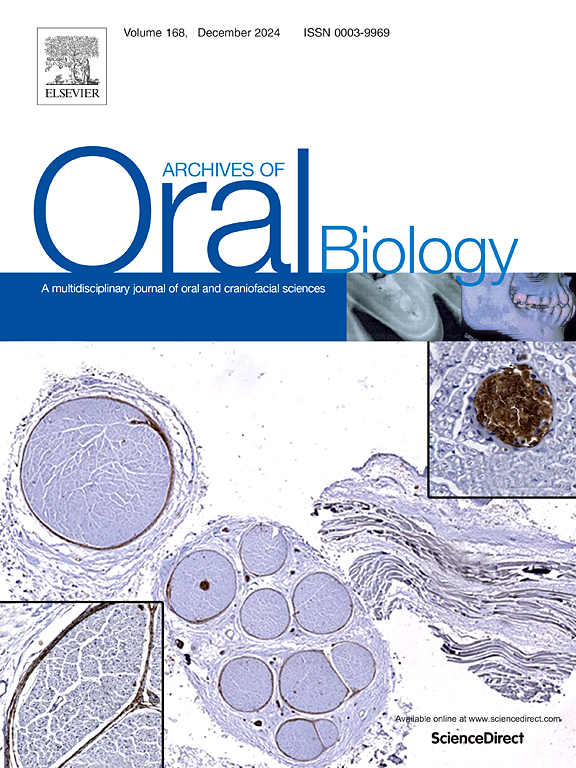颞下颌障碍与五种精神障碍双向因果关系的调查。
IF 2.2
4区 医学
Q2 DENTISTRY, ORAL SURGERY & MEDICINE
引用次数: 0
摘要
目的:本研究采用双样本孟德尔随机化(TSMR)方法探讨颞下颌障碍(TMD)与5种精神障碍的双向因果关系。方法:从全基因组关联研究(GWAS)数据库中提取与TMD相关的单核苷酸多态性(snp)。选择的SNPs作为工具变量(IVs)需要与暴露表型有很强的相关性,并满足孟德尔随机化(MR)分析的假设。TSMR分析的主要方法是逆方差加权法(IVW)。此外,加权中位数、加权模式和MR Egger方法作为次要方法,以确保结果的可靠性和可信度。此外,还进行了异质性、多效性和敏感性试验,以确保结果的准确性和稳健性。在MR分析后,我们进行反向分析,探讨TMD与五种精神障碍之间的双向关联。结果:本研究提供了TMD与焦虑(P = 5.94 × 10-15, OR = 1.5253, 95 % CI = 1.3719-1.6959)和抑郁(P = 3.79 × 10-12, OR = 1.4243, 95 % CI = 1.2890-1.5738)呈正相关的证据。在反向TSMR分析中,焦虑与TMD呈正相关(P = 0.0126,OR = 1.0664, 95 % CI = 1.0139-1.1217)。然而,TMD与抑郁、失眠、双相情感障碍或精神分裂症之间没有因果关系(P > 0.05)。结论:TMD与焦虑之间存在双向关系,TMD也可能促进抑郁的发展。本文章由计算机程序翻译,如有差异,请以英文原文为准。
Investigation of bidirectional causal association between temporomandibular disorders and five mental disorders
Objective
This study utilized two-sample Mendelian randomization (TSMR) to investigate the bidirectional causal associations between temporomandibular disorders (TMD) and five mental disorders.
Methods
Single-nucleotide polymorphisms (SNPs) linked to TMD were extracted from the Genome-Wide Association Studies (GWAS) database. The SNPs selected as instrumental variables (IVs) were required to have strong associations with the exposure phenotype and to meet the assumptions of Mendelian randomization (MR) analysis. The primary method employed for TSMR analysis was the Inverse Variance-Weighted (IVW) method. Additionally, the Weighted Median, Weighted Mode, and MR Egger methods were used as secondary approaches to ensure the reliability and credibility of the results. Furthermore, heterogeneity, pleiotropy, and sensitivity tests were conducted to ensure the accuracy and robustness of the findings. After MR analysis, we performed reverse analysis to explore the bidirectional association between TMD and five mental disorders.
Results
Our study provided evidence of a positive correlation between TMD and both anxiety (P = 5.94 × 10−15, OR = 1.5253, 95 % CI = 1.3719–1.6959) and depression (P = 3.79 × 10−12, OR = 1.4243, 95 % CI = 1.2890–1.5738). In the reverse TSMR analysis, a positive association was found between anxiety and TMD (P = 0.0126, OR = 1.0664, 95 % CI = 1.0139–1.1217). However, no causal relationship was found between TMD and depression, insomnia, bipolar disorder, or schizophrenia (P > 0.05).
Conclusion
These evidences indicated a bidirectional relationship between TMD and anxiety, and TMD may also contribute to the development of depression.
求助全文
通过发布文献求助,成功后即可免费获取论文全文。
去求助
来源期刊

Archives of oral biology
医学-牙科与口腔外科
CiteScore
5.10
自引率
3.30%
发文量
177
审稿时长
26 days
期刊介绍:
Archives of Oral Biology is an international journal which aims to publish papers of the highest scientific quality in the oral and craniofacial sciences. The journal is particularly interested in research which advances knowledge in the mechanisms of craniofacial development and disease, including:
Cell and molecular biology
Molecular genetics
Immunology
Pathogenesis
Cellular microbiology
Embryology
Syndromology
Forensic dentistry
 求助内容:
求助内容: 应助结果提醒方式:
应助结果提醒方式:


